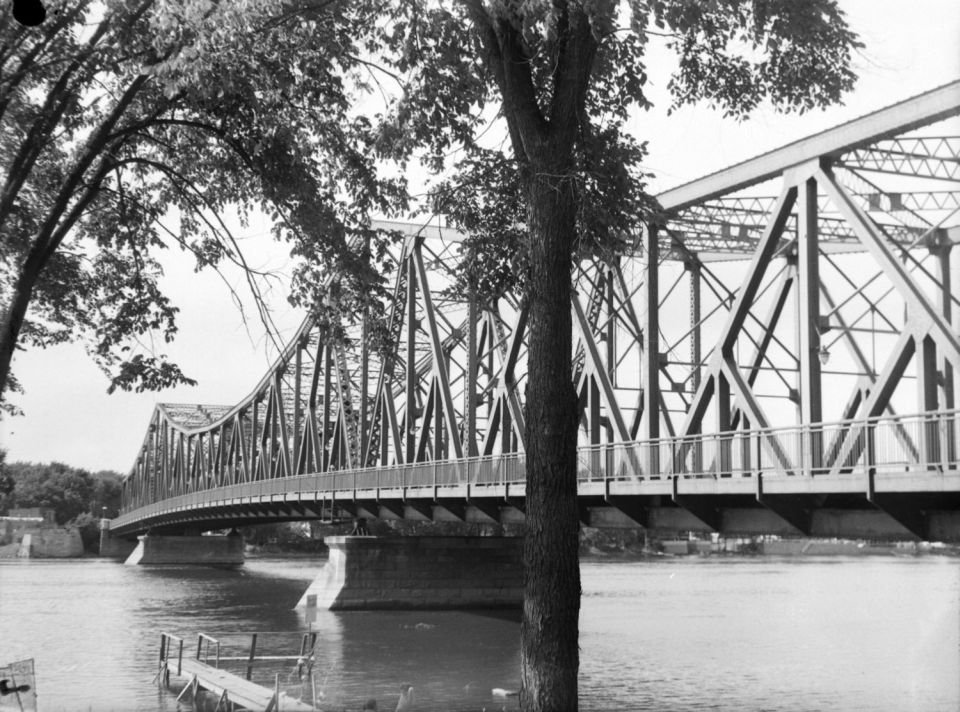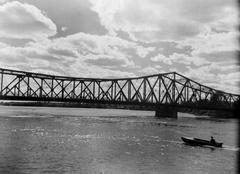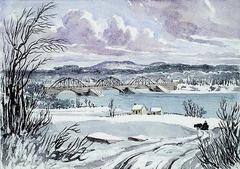
Lachapelle Bridge Montreal: Visiting Hours, Tickets, and Tourist Guide
Date: 15/06/2025
Introduction: The Historical and Cultural Landmark of Lachapelle Bridge
Lachapelle Bridge, also known as the Cartierville Bridge, is a prominent historical and architectural landmark connecting Montreal to Laval across the Rivière des Prairies. From its humble beginnings in 1836 as a wooden bridge replacing a ferry service, the structure has evolved into a dual-span steel and concrete crossing, reflecting both the region’s rich heritage and its ongoing urban growth. As the first bridge to span a river in Montreal, Lachapelle Bridge played a pivotal role in economic development, suburban expansion, and the cultural integration of the Greater Montreal area. Today, it remains an essential transportation artery, scenic pedestrian and cycling route, and a symbol of the community’s enduring spirit (Community Stories, Historic Bridges, Chapitre 2 Productions).
This detailed guide covers the bridge’s history, engineering, cultural significance, and provides practical information for visitors—including accessibility, nearby attractions, and travel tips. Whether you’re a history buff, commuter, cyclist, or tourist, this resource will enhance your experience and appreciation of one of Montreal’s most iconic crossings.
Table of Contents
- Introduction
- Early Origins and First Crossings
- Structural Evolution: From Timber to Steel and Concrete
- Architectural and Engineering Highlights
- Role in Regional and Economic Development
- Visiting Lachapelle Bridge: Hours, Access, and Tips
- Notable Events and Transformations
- Frequently Asked Questions (FAQ)
- Visuals and Nearby Sites
- Conclusion and Call to Action
- Sources and Further Reading
Early Origins and First Crossings
Prior to the construction of any bridge, the Rivière des Prairies was crossed by ferries—an unreliable mode prone to weather disruptions that restricted trade and movement. The region’s growing population and burgeoning commerce necessitated a permanent connection. The first Lachapelle Bridge was built in 1836 at an old ferry crossing, providing a vital link between Montreal and Île Jésus (now Laval) (Community Stories). This wooden bridge not only allowed for the movement of people and goods but also marked a transformative point in local infrastructure and urbanization.
Structural Evolution: From Timber to Steel and Concrete
19th Century Engineering
The original wooden bridge quickly became central to daily life and commerce. By 1839, a timber truss bridge replaced the first structure, demonstrating advances in engineering and the scale of local traffic. In 1882, the timber bridge was superseded by an iron bridge, likely a pin-connected Camelback through truss—a design favored in North America for its strength and effective load distribution (Historic Bridges).
20th Century Spans
The need for modernization led to the construction of the current dual-span design:
- 1930 Span: A three-lane continuous steel through truss bridge, serving northbound traffic into Laval. Its robust structure and industrial design reflect the era’s engineering prowess and the growing importance of automobile travel.
- 1975-1976 Span: A through arch bridge accommodating southbound traffic into Montreal. This modern span, with its streamlined aesthetic and minimized river piers, was built to address increased traffic and environmental concerns (Touristlink).
The two spans, while parallel, differ in length, pier placement, and structural design—creating a living display of evolving bridge technology.
Architectural and Engineering Highlights
The Lachapelle Bridge is unique in Montreal for its juxtaposition of two structurally distinct spans:
- 1930 Steel Through Truss: Features continuous truss elements and steel fabrication from major North American producers. The bridge’s original low sway bracing was later modified for increased navigational clearance (Historic Bridges).
- 1975 Through Arch: Employs modern steelwork, a visually striking arch, and fewer piers to protect the river environment.
The bridge’s location and design also offer panoramic views of Montreal and Laval, making it a favorite for photographers and urban explorers.
Role in Regional and Economic Development
Urban Growth and Connectivity
Lachapelle Bridge was instrumental in transforming Laval from a rural area into a major suburb. Its presence fostered daily commuting, residential growth, and commercial expansion. Population in Laval surged from 21,631 in 1941 to over 196,000 in 1966 (Community Stories). The bridge also feeds into Autoroute 15, further integrating Montreal and Laval’s transportation networks.
Economic and Cultural Impact
The bridge enhances local commerce by improving access to shops, markets, and cultural sites. It supports jobs in transportation, retail, and tourism, and helps local businesses thrive by attracting both commuters and visitors (thetourism.institute, canadiantechnologymagazine.com). Community events and heritage tours highlight the bridge’s continuing relevance.
Visiting Lachapelle Bridge: Hours, Access, and Tips
Visiting Hours and Ticket Information
- Access: The bridge is open 24/7 to pedestrians, cyclists, and vehicles.
- Fees: There are no tolls or entrance fees.
Getting There and Accessibility
- By Car: Part of Boulevard Laurentien (Route 117), with nearby parking on residential streets.
- Public Transit: Served by STM and STL bus routes. The nearest metro is Côte-Vertu (Orange Line) with bus connections.
- Cycling and Walking: Dedicated lanes for cyclists and pedestrians; accessible ramps and wide sidewalks.
- Accessibility: Suitable for wheelchairs and strollers, though winter conditions may require extra caution.
Best Times and Safety Tips
- Best Times: Early mornings and late afternoons for photography; avoid peak rush hour traffic.
- Safety: Use designated paths, keep right, and be alert for bikes and other pedestrians. The bridge is well-lit at night, but daytime visits are recommended for best views.
Nearby Attractions
- Ahuntsic-Cartierville Borough: Local shops, eateries, and parks.
- Sault-au-Récollet District: Heritage buildings, riverside parks, and the Persillier-Dit-Lachapelle house.
- Île de la Visitation Nature Park: Trails, picnic spots, and educational panels.
- Laval’s Chomedey Neighborhood: Parks, commercial centers, and access to larger green spaces.
Notable Events and Transformations
Historical Milestones
- 1837-38 Patriotes’ Rebellion: The bridge was a strategic site during this period, targeted but never destroyed by insurgents.
- Maintenance and Modernization: Regular upgrades have kept the bridge safe and functional, including resurfacing, structural reinforcement, and improved traffic management.
- Cultural Celebrations: Community events, heritage tours, and public art projects reinforce its role as a local landmark.
Frequently Asked Questions (FAQ)
Q: Is there a fee or ticket required to visit or cross the bridge?
A: No, the bridge is free to use at all times.
Q: Are pedestrians and cyclists welcome?
A: Yes, there are dedicated lanes for both.
Q: When is the best time to visit?
A: Daytime hours, especially in spring through autumn, are ideal for views and safety.
Q: Is the bridge accessible for those with reduced mobility?
A: Yes, there are ramps and wide paths, but take care during winter.
Q: Are guided tours available?
A: Local heritage groups sometimes organize walking tours that include the bridge; check event calendars for details.
Visuals and Nearby Sites
Caption: Dramatic sunset over the Lachapelle Bridge’s through arch span.
Caption: The original 1930 steel truss span, a testament to early 20th-century engineering.
Explore related Montreal historical sites:
Conclusion and Call to Action
Lachapelle Bridge is more than just infrastructure—it’s a living link between Montreal’s past and present. Its dual spans showcase the evolution of bridge engineering, while its accessible paths, scenic views, and proximity to parks and neighborhoods make it a destination for locals and tourists alike. Use this guide to plan your visit, explore the bridge’s history, and connect with Montreal’s vibrant urban life.
For more travel tips, guided tours, and up-to-date information on Montreal’s historical sites, download the Audiala app and follow us on social media. Be sure to check related articles about Montreal’s bridges and urban heritage for a deeper appreciation of this dynamic city.
Sources and Further Reading
- Community Stories
- Historic Bridges
- Chapitre 2 Productions
- Touristlink
- RouteYou
- thetourism.institute
- canadiantechnologymagazine.com
- Quebec Wonders





























































































































